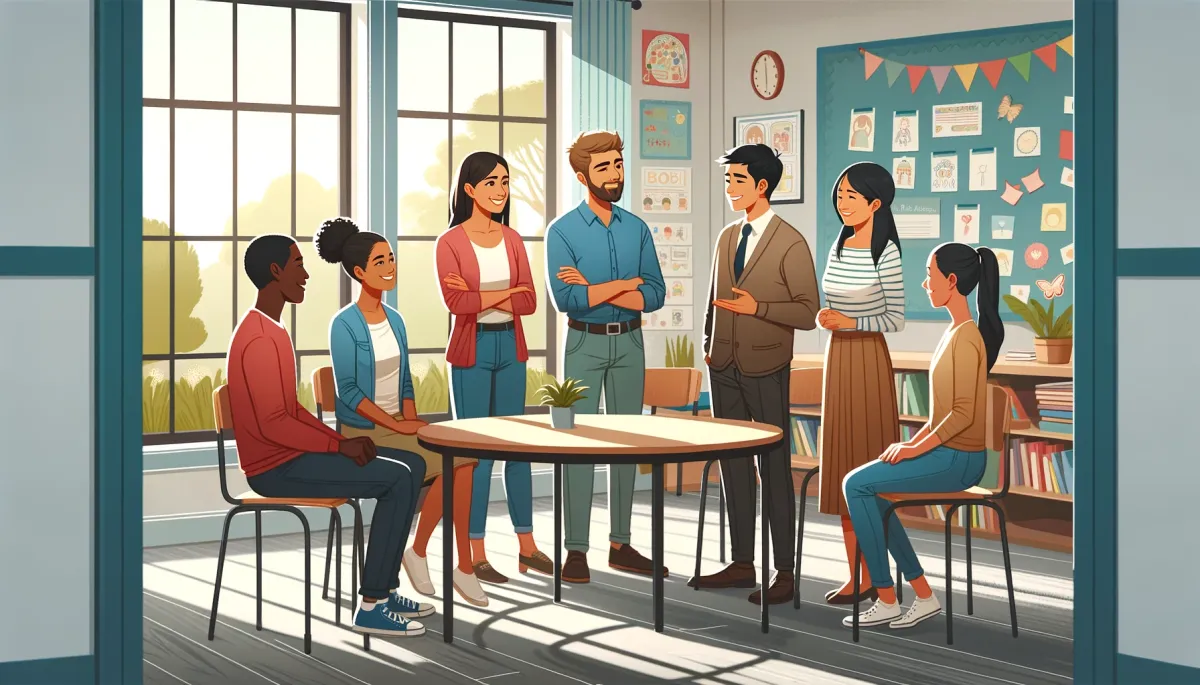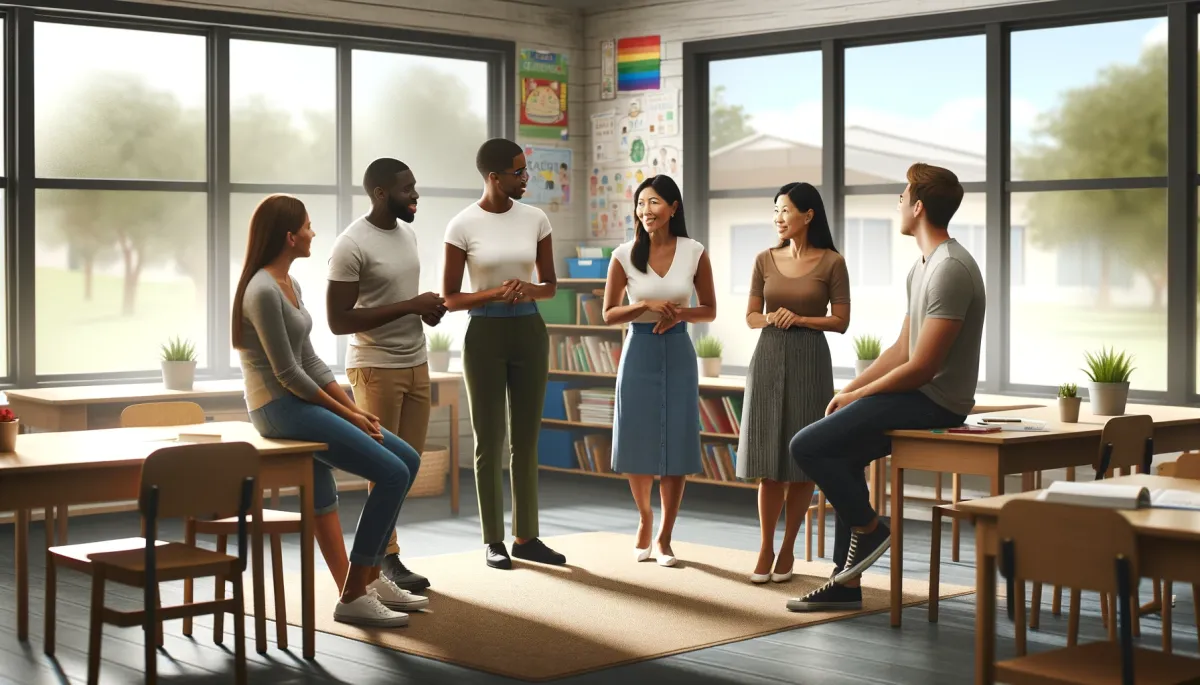Communicating Effectively with Parents of Students

Fanie Naude
CEO & Founder of Knowledgeable Tutor, Buznet Direct, YMC & Naude Consulting

Fanie Naude
CEO & Founder of Knowledgeable Tutor, Buznet Direct, YMC & Naude Consulting
In This Article
II. The Importance of Parent-Teacher Communication
III. Setting the Stage: First Impressions
VI. Respectful and Clear Communication
VII. Understanding Different Online Tutoring Platforms
VIII. Parent-Teacher Conferences
IX. Addressing Sensitive Issues
X. Maintaining Student Engagement in Online Tutoring
XI. Regular Updates and Feedback
XII. Tools and Technology for Effective Online Tutoring
XIII. Legal and Ethical Considerations

I. Introduction
The role of an educator extends far beyond the confines of the classroom. One of the most critical aspects of this multifaceted profession is effective communication with parents. As the adage goes, "It takes a village to raise a child," and in the context of education, parents and teachers are key villagers in that proverbial community. The synergy between home and school environments can significantly impact a student's academic success, emotional well-being, and overall development.
"Communication—the human connection—is the key to personal and career success," said Paul J. Meyer, a pioneer in the self-improvement industry. This statement rings especially true for educators who are not just imparting knowledge but are also shaping young minds. Effective communication with parents is not merely a professional requirement but a cornerstone for a child's holistic education.
Why This Article?
- Equip Educators: Provide actionable strategies for effective parent-teacher communication.
- Address Challenges: Identify common obstacles and offer practical solutions.
- Data-Driven Insights: Back up claims with credible data and expert opinions.

II. The Importance of Parent-Teacher Communication
Why It Matters for Student Success
The significance of robust parent-teacher communication cannot be overstated. A study by Harvard University reveals that effective communication between parents and teachers can improve a child's academic performance by up to 50%. This is not just a number but a testament to the power of collective effort in nurturing a child's educational journey.
Key Benefits:
- Enhanced Academic Performance: Students perform better when their parents are involved in their education.
- Emotional Well-being: Open communication channels can help in identifying and addressing emotional or behavioral issues at an early stage.
- Holistic Development: It fosters a well-rounded development by aligning educational goals and extracurricular activities between home and school.
Data-Backed Benefits
According to the National Education Association, students with involved parents are more likely to:
- Earn higher grades and test scores.
- Enroll in higher-level programs.
- Attend school regularly.
- Have better social skills.
- Show improved behavior.
- Graduate and go on to post-secondary education.
Table: Impact of Parent-Teacher Communication on Student Outcomes
| Metrics | With Effective Communication | Without Effective Communication |
|---|---|---|
| Grades | Higher (A-B range) | Lower (C-D range) |
| Attendance | Regular | Irregular |
| Emotional Well-being | Stable | Fluctuating |
The data clearly indicates that effective parent-teacher communication is not just a 'nice-to-have' but a 'must-have' for achieving superior educational outcomes. As the famous educator James Comer said, "No significant learning can occur without a significant relationship." This relationship is not just between the teacher and the student but extends to involve parents as well.
In the next section, we will delve into how to set the stage for effective communication right from the first interaction. We will explore the nuances of first impressions and why they are crucial in establishing a long-lasting, productive relationship with parents.
Stay tuned as we unravel the art and science of effective communication in the educational realm.

III. Setting the Stage: First Impressions
How to Initiate the First Contact
The first interaction between a tutor and a parent is akin to laying the cornerstone for a building; it sets the foundation for all future interactions. Whether it's an introductory email, a phone call, or a face-to-face meeting, the initial contact must be planned and executed with utmost care. A well-crafted introductory email, for instance, can serve as a powerful tool to set the tone for future communications. It should include:
- Brief Introduction: Who you are and your educational background.
- Purpose: Why you are reaching out.
- Expectations: What parents can expect in terms of communication frequency and channels.
Importance of Setting a Positive Tone
Setting a positive tone in the first interaction is not just good manners but a strategic move. According to Psychology Today, first impressions are formed within the initial seven seconds of a meeting. These impressions can significantly influence a parent's willingness to engage and collaborate in their child's educational journey.
Tips for Setting a Positive Tone:
- Be Professional: Use formal language and maintain a respectful demeanor.
- Be Open: Show that you are approachable and open to dialogue.
- Be Positive: Highlight the potential for a successful educational partnership.

IV. Channels of Communication
Emails, Newsletters, Parent Portals
In today's digital age, there are multiple channels available for communication between tutors and parents. Each has its own set of advantages and limitations. Here's a quick rundown:
- Emails: Direct and formal, but can get lost in the inbox clutter.
- Newsletters: Great for mass updates but lack personalization.
- Parent Portals: Interactive and real-time but require tech-savvy parents.
For a more in-depth look at how technology can aid in effective communication, you may refer to our guide on Understanding Different Online Tutoring Platforms.
Pros and Cons of Each
| Channel | Pros | Cons |
|---|---|---|
| Direct, Formal | Can be Ignored | |
| Newsletters | Mass Updates | Lack of Personalization |
| Parent Portals | Real-time, Interactive | Requires Tech Proficiency |
Choosing the right channel depends on various factors such as the urgency of the message, the complexity of the information, and the tech proficiency of the parents. It's often beneficial to use a combination of these channels to ensure effective communication.
In the next section, we will delve into the art of listening, a skill often overlooked but crucial in effective communication. As Stephen R. Covey aptly put it, "Most people do not listen with the intent to understand; they listen with the intent to reply."
Stay tuned as we continue to explore the multifaceted world of effective communication between tutors and parents.

V. The Art of Listening
Active Listening Techniques
Listening is not merely a passive act; it's an active process that requires full engagement. Active listening is a skill that can significantly enhance the quality of communication between tutors and parents. It involves not just hearing the words but understanding the emotions and intentions behind them. Here are some techniques to master the art of active listening:
- Reflective Listening: Mirror the speaker's emotions and sentiments in your responses.
- Paraphrasing: Summarize what you've heard to show understanding.
- Questioning: Ask open-ended questions to encourage dialogue.
- Non-Verbal Cues: Maintain eye contact and nod to show you're engaged.
"Most people do not listen with the intent to understand; they listen with the intent to reply." - Stephen R. Covey
Stephen R. Covey's quote encapsulates the essence of why active listening is so crucial. When we listen to reply, we are only processing information on a superficial level. However, when we listen to understand, we delve deeper, fostering a more meaningful and productive conversation. This is especially vital when discussing a student's progress or challenges.

VI. Respectful and Clear Communication
Dos and Don'ts
Respectful communication is the cornerstone of any successful relationship, including that between tutors and parents. It's not just what you say but how you say it that matters. Here are some dos and don'ts:
- Do: Use polite language and maintain a professional tone.
- Don't: Use jargon or acronyms that parents may not understand.
- Do: Be transparent and honest in your communication.
- Don't: Make promises you can't keep or set unrealistic expectations.
Cultural Sensitivity
In an increasingly globalized world, tutors often find themselves interacting with parents from diverse cultural backgrounds. Being culturally sensitive is not just an ethical requirement but also enhances the effectiveness of communication. For instance, some cultures value direct communication, while others may find it confrontational.
Tips for Culturally Sensitive Communication:
- Research: Understand the cultural background of the student and their family.
- Adapt: Modify your communication style to align with cultural norms.
- Inclusive Language: Use language that is inclusive and respectful of cultural differences.
For more insights into respectful and ethical practices in online tutoring, you may refer to our guide on Ethical Practices in Online Tutoring.
In the upcoming sections, we will explore how technology can be leveraged for effective communication and what to keep in mind during parent-teacher conferences. Stay tuned as we continue to navigate the intricate landscape of tutor-parent communication.

VII. Understanding Different Online Tutoring Platforms
How Technology Can Aid Communication
In the digital age, technology serves as a bridge that connects tutors and parents in a seamless communication loop. Online tutoring platforms offer various features that can enhance this communication, from real-time chat options to video conferencing and digital report cards.
Key Features to Look For:
- Real-Time Messaging: Enables instant communication.
- Video Conferencing: Facilitates face-to-face interaction.
- Notification Systems: Keeps parents updated on their child's progress.
- Digital Report Cards: Allows for easy sharing of academic records.
For a comprehensive understanding of how different platforms can serve your needs, you may refer to our guide on Understanding Different Online Tutoring Platforms.

VIII. Parent-Teacher Conferences
Best Practices
Parent-teacher conferences are a traditional yet effective method of establishing a strong communication link between tutors and parents. These meetings provide an opportunity for in-depth discussions about the student's academic performance, behavioral issues, and future goals.
Steps for a Successful Conference:
- Preparation: Gather all necessary materials, including academic records and specific examples of the student's work.
- Agenda: Have a clear agenda to ensure that all important topics are covered.
- Time Management: Stick to the allocated time to respect the parent's schedule.
- Follow-Up: Summarize the key points discussed and outline the next steps.
Common Mistakes to Avoid
While parent-teacher conferences can be highly productive, certain pitfalls can hinder effective communication.
- Lack of Preparation: Coming unprepared can lead to a vague and unproductive discussion.
- Defensiveness: Being defensive about criticism can close off constructive dialogue.
- Overwhelming Information: Bombarding parents with too much information can be counterproductive.
By adhering to these best practices and avoiding common mistakes, you can make parent-teacher conferences a cornerstone of effective communication. For more tips on balancing your tutoring responsibilities, you may find our guide on Effective Time Management Strategies for Online Tutors useful.
In the following sections, we will delve into how to address sensitive issues and the importance of maintaining student engagement in online tutoring. Stay tuned as we continue to explore the multifaceted aspects of effective communication with parents.

IX. Addressing Sensitive Issues
How to Approach Difficult Topics
Navigating sensitive topics with parents is a delicate endeavor that requires tact, empathy, and strategic planning. Whether it's discussing academic challenges, behavioral issues, or special needs, the approach must be carefully calibrated to foster a constructive dialogue.
Steps for Tactful Communication:
- Preparation: Research the issue thoroughly to present facts and possible solutions.
- Empathy: Put yourself in the parents' shoes to understand their concerns.
- Confidentiality: Ensure that the conversation remains private and respectful.
- Solution-Oriented: Focus on actionable steps rather than dwelling on the problem.
Case Studies
Real-life examples can offer invaluable insights into how to handle these delicate situations. One such case study highlights the importance of family-school partnerships in improving students' academic outcomes. Another study focuses on the dilemmas in family-school-community relations, especially among low-income and culturally diverse families.

X. Maintaining Student Engagement in Online Tutoring
How Engagement Affects Parent-Teacher Relations
Student engagement is not just beneficial for academic success; it also plays a pivotal role in shaping the dynamics of parent-teacher communication. When students are engaged, parents are more likely to have a positive perception of the tutor, thereby facilitating easier and more productive conversations.
The Engagement-Communication Loop:
- Active Participation: Engaged students make parents more receptive to tutor communication.
- Positive Feedback: Parents are more likely to respond positively to tutors when they see their children actively participating.
- Trust Building: High levels of student engagement can build trust between parents and tutors.
For more insights into maintaining student engagement, you may refer to our guide on Maintaining Student Engagement in Online Tutoring.
In the subsequent sections, we will explore the importance of regular updates and feedback, as well as the tools and technology that can facilitate effective communication with parents. Stay tuned for more in-depth analysis and actionable tips.

XI. Regular Updates and Feedback
Importance of Keeping Parents in the Loop
The adage "No news is good news" doesn't apply in the realm of parent-teacher communication. Regular updates are not just courteous; they're crucial for maintaining a healthy, transparent relationship. Parents appreciate being informed about their child's progress, challenges, and any changes in the tutoring plan.
Key Components of Effective Updates:
- Timeliness: Updates should be frequent but not overwhelming.
- Relevance: Information should be pertinent to the student's academic progress.
- Clarity: Avoid educational jargon; keep it simple and understandable.
Tools for Effective Feedback
Feedback is a two-way street. While tutors provide insights into a student's academic performance, parents can offer valuable information about the child's learning environment at home, emotional state, and other factors that may affect learning.
Recommended Tools:
- Digital Portfolios: Platforms like Seesaw allow for real-time updates.
- Feedback Forms: Google Forms can be used for periodic parent surveys.
- Automated Reports: Tools like TutorCruncher can send automated performance reports.
For a deeper dive into the tools that can make your tutoring more effective, check out our guide on Tools and Technology for Effective Online Tutoring.

XII. Tools and Technology for Effective Online Tutoring
Software and Apps that Facilitate Communication
In the digital age, leveraging the right tools can significantly enhance your communication with parents. From messaging apps to parent portals, technology can streamline the exchange of information, making it more efficient and interactive.
Types of Tools:
- Communication Platforms: Apps like Remind or ClassDojo facilitate quick messaging.
- Learning Management Systems (LMS): Platforms like Moodle or Blackboard offer comprehensive features including forums, grade books, and more.
- Parent Portals: Dedicated sections in LMS or separate apps where parents can view academic records, attendance, and other key metrics.
Pros and Cons of Each Tool
While technology offers numerous advantages, it's essential to be aware of potential drawbacks, such as data privacy concerns or the digital divide affecting some families.
Comparative Table:
| Tool Type | Pros | Cons |
|---|---|---|
| Communication Platforms | Quick, real-time communication | Limited to short messages |
| LMS | Comprehensive, all-in-one solution | Steeper learning curve |
| Parent Portals | Tailored for parent interaction | May require separate registration |
For more insights into the different platforms you can use for online tutoring, refer to our guide on Understanding Different Online Tutoring Platforms.
In the following sections, we will delve into the legal and ethical considerations that come with communicating effectively with parents, as well as effective time management strategies for online tutors. Stay tuned for more nuanced discussions and practical tips.

XIII. Legal and Ethical Considerations
FERPA and Other Regulations
The Family Educational Rights and Privacy Act (FERPA) is a federal law that protects the privacy of student education records. As an online tutor, you are obligated to adhere to these regulations, ensuring that any communication with parents is compliant with privacy laws.
Key Points to Remember:
- Confidentiality: Never disclose sensitive student information without explicit consent.
- Data Security: Use secure platforms for communication to protect against data breaches.
- Transparency: Be upfront about how you handle and store student data.
Ethical Practices in Online Tutoring
Beyond legal obligations, ethical considerations should guide your interactions with parents. This includes honesty in reporting student progress, respecting cultural differences, and maintaining professional boundaries.
Ethical Guidelines:
- Integrity: Always be truthful in your communications.
- Respect: Acknowledge and honor the diverse backgrounds of your students and their families.
- Professionalism: Maintain a professional demeanor in all interactions.
For a comprehensive understanding of the legal and ethical landscape in online tutoring, you may find our guide on Ethical Practices in Online Tutoring beneficial.

XIV. Effective Time Management Strategies for Online Tutors
Balancing Communication Efforts with Other Responsibilities
Effective communication with parents is essential, but it's just one of many responsibilities you juggle as an online tutor. Time management is crucial to ensure that you can maintain this balance without compromising the quality of your tutoring or your well-being.
Time Management Tips:
- Prioritize: Determine which communications are most urgent and address them first.
- Schedule: Allocate specific times for parent communication to avoid constant interruptions.
- Automate: Use tools to automate routine communications, like progress reports.
Real-life Example: The Pomodoro Technique
The Pomodoro Technique is a time management method that involves breaking work into intervals, traditionally 25 minutes, separated by short breaks. This can be particularly effective for managing communication tasks alongside tutoring sessions.
For more on this, our guide on Effective Time Management Strategies for Online Tutors offers a wealth of information.
In the next section, we will address frequently asked questions and common misconceptions about communicating effectively with parents of students. This will serve as a valuable resource for both new and experienced online tutors.

Conclusion: The Keystone of Parent-Tutor Communication
Effective communication with parents is not an auxiliary skill but a cornerstone in the edifice of online tutoring. This comprehensive guide has aimed to equip you with strategies, from initiating contact to navigating sensitive issues and legal considerations. As Anne Morrow Lindbergh aptly said, "Good communication is just as stimulating as black coffee." It's the catalyst for a more enriched learning experience for the student and a more fulfilling teaching journey for you. In this ever-evolving landscape, adaptability and continuous learning are your allies. Let's dispel the illusion that communication has occurred and truly connect, making our 'digital village' a more effective space for education.

XV. Communicating Effectively with Parents of Students: FAQs
In this section, we'll address some of the most frequently asked questions about communicating effectively with parents of students. These questions and answers are designed to provide a quick reference guide for both new and experienced online tutors.
1. What is the Importance of Effective Communication with Parents?
Effective communication with parents is crucial for a child's academic success. It fosters a collaborative environment, ensures that both parties are on the same page regarding the child's needs, and helps in early identification of any issues that may require intervention.
2. How Do I Initiate the First Contact with Parents?
The first contact should be initiated as soon as possible, ideally before the first tutoring session. This can be done via email, phone call, or through the tutoring platform you're using. The aim is to set a positive tone and establish open lines of communication.
3. What Channels of Communication Should I Use?
Emails, newsletters, and parent portals are commonly used channels. Each has its pros and cons, so it's essential to choose the one that best suits your needs and those of the parents. For more on this, refer to our section on Channels of Communication.
4. What is Active Listening and Why is it Important?
Active listening involves fully concentrating, understanding, responding, and remembering what the other person is saying. It's crucial for building trust and understanding between you and the parents.
5. How Do I Address Sensitive Issues?
Sensitive issues should be approached with care, tact, and professionalism. Always choose a private and comfortable setting for such discussions, whether it's a virtual meeting or a phone call.
6. What Tools Can Aid in Effective Communication?
Various software and apps can facilitate communication, from messaging apps to parent-teacher communication platforms. For a detailed list, you can refer to our guide on Tools and Technology for Effective Online Tutoring.
7. How Do I Balance Communication with Other Tutoring Responsibilities?
Effective time management is key. Prioritize urgent communications, allocate specific times for parent interactions, and consider automating routine updates.
8. What are the Legal and Ethical Considerations?
You must adhere to FERPA regulations and maintain ethical standards in all your communications. For more on this, consult our section on Legal and Ethical Considerations.
9. How Often Should I Update Parents?
Regular updates are essential but the frequency can vary depending on the student's needs and parent preferences. Some may prefer weekly updates, while others may be content with a monthly summary.
10. How Can I Improve My Communication Skills?
Continuous learning and professional development are key. Attend workshops, read relevant literature, and consider courses that focus on communication skills.
This FAQ section aims to be a comprehensive resource, answering questions that are commonly found in Google's "People Also Ask" section. For more in-depth information on each of these topics, please refer to the respective sections in this guide.

